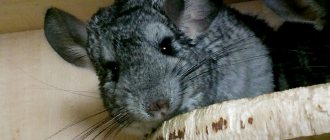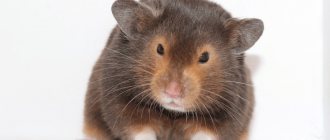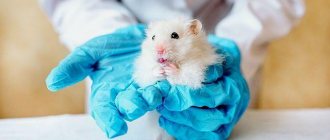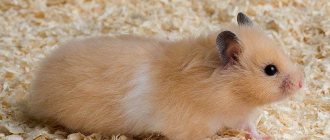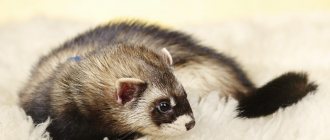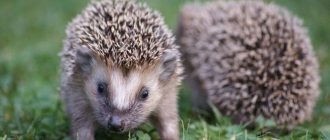Even Bruce Willis, Vin Diesel and a little bit of Marx and Lenin are jealous of these stylish and sleek beauties. These creatures delight with their genuine and sincere baldness. They are clean of hair and beautiful in appearance. True, some of them really want to be warmed up.
This is what an owl looks like without feathers
A completely bald hedgehog who lost his quills due to illness
Sphinxes
Many people don’t like this breed, but I really like them!
Rabbit
This rabbit was born without hair, but that doesn't stop him from enjoying life.
Wombat
This wombat is still small, and it will grow in a month.
Bald bear
This female went bald due to a genetic disease, but eventually she bounced back!
Mexican hairless dog
Raccoon
Wild animals often suffer from mange, which causes hair loss, which is what happened to this raccoon.
Hairless guinea pig
Rats also have such a breed - the Sphynx.
Bald chimpanzee
Chimpanzees suffer from alopecia, a condition that leads to hair loss. It is also common in humans.
During the course of evolution, humans have lost most of their hair, unlike simple animals who still have to deal with the harsh conditions of life in nature, in forests, steppes and in cold water. But there are types of animals that can also boast of smooth skin, although it looks very unusual. Whether it’s cute or scary – judge for yourself.
1. Abandoned hairless guinea pig becomes an Instagram star
A male guinea pig named Ludwik has experienced a series of amazing changes in just one year. First, the poor guy was thrown out, then he ended up in an animal rescue center, and in the end he was given into the good hands of new loving owners who helped him become an Internet star.
His current owner, Agata Nowacka, first saw the animal completely sick, suffering from fungus and other ailments. The woman sheltered the baby and nursed him until he fully recovered. In 2015, Ludwig opened his own profile on Instagram, to which about 15,000 people have already subscribed.
By the way, in fact, this pig is not bald, but simply belongs to such a hairless breed of rodents. Special care for this cute pet involves weekly bathing and a certain regime of skin moisturizing.
2. Due to a mysterious disease, bears in a German zoo have gone bald.
Veterinarians are at a loss as to why the female bears at the Leipzig Zoo suddenly began to go bald. In 2012, for a mysterious reason, three females, Dolores, Lolita, and Bianca, lost hair on their heads, paws, and backs. Usually, before winter, these animals grow even thicker hair in order to prepare for the cold season. But the famous bears had to stay close to each other for some time to avoid freezing until doctors found a suitable treatment for this disease.
3. The “naked” parrot has become a real muse and encouragement for the disabled
Sweet Rhea is a hairless bird suffering from beak problems and a skin condition that has caused her to lose all her feathers. But the lack of plumage is more than compensated by the attention of a loving owner and a whole crowd of fans from the Internet who follow the charismatic and cute bird on Instagram.
Looking at photos of Sweet Rhea, one cannot help but notice that she has a rich inner world! The daily adventures and elegant costumes of this feathered creature have made the parrot a real star of the World Wide Web. Rhea has even become a symbol of overcoming for people with physical disabilities, as she tirelessly proves that there is nothing wrong in being somehow different from the rest.
4. Bald hamster wears sweaters to keep warm
Meet Silky, a charming female hamster who was abandoned by her previous owners when they were faced with the choice of whether to treat the pet or abdicate responsibility for the tamed animal. She now lives at the Oregon Humane Society.
Silka has a very unique quality - thanks to a genetic mutation, she is completely bald, and is also much smaller in size and thinner than ordinary hamsters of her breed. In addition, it needs additional insulation during cold seasons.
A shelter employee who cares for animals, Selene Mejia, was very worried about the hamster freezing in the corner of her cage, and knitted a sweater for the animal. The clothes fit Silka's figure perfectly and pleasantly warm her delicate and sensitive skin.
5. A wetsuit company helped out a freezing penguin.
Unlike most penguins, who molt regularly, Ralph, for some reason, does not renew his fur. Because of this, the poor 16-year-old Humboldt penguin is very sensitive to the winter cold. Due to its unusual coat, it is also very susceptible to sunburn. But the animal was not allowed to disappear - the famous American brand of sportswear and surfing equipment O'Neill invented and sewed a special wetsuit for Ralph. It even has the animal's name on it. The suit, with holes for his wings and head, allows Ralph to feel completely at ease and play with his friends at the Marwell Wildlife Center in Winchester, Hampshire.
6. Israeli scientists have created a new breed of chicken in the laboratory that has no feathers.
Behold the hairless chicken, bred by scientists at the genetics department of the Rehovot Agricultural Institute in Tel Aviv! No, she was not plucked, and yes, she was born this way. The new type will allow livestock farms to deal with more “convenient” poultry, on which they can save a lot of money.
This is especially true for farmers and factories in overly hot countries, where richly feathered chickens simply cannot withstand the high temperatures and require barns with expensive climate control. Now it will be possible to finally save on electricity and direct funds to other projects.
Critics of the faculty's work believe that the new type of chicken without feathers will be more vulnerable and sickly than ordinary birds. Roosters may have problems mating. Now they will not be able to flap their wings, as they instinctively do to attract females during the mating season. In addition, both hens and roosters can have health problems due to skin parasites, mosquito bites and sunburn.
7. Meet Ashiz, a 13-year-old hairless chimpanzee
Ashes is a hairless primate, but at birth he had beautiful fur. A year later, the animal became completely bald and has remained “naked” ever since. Ashiz is believed to suffer from a skin condition called alopecia, which also affects humans.
Just look at his paws! Now it’s clear why you should be wary of these animals. With such muscles, they can easily cause a lot of damage if they get angry.
8. The Bald Peruvian dog breed, which is on the verge of extinction
The Peruvian Inca Orchid, or simply the Hairless Peruvian, is one of the rarest and strangest dog breeds on Earth. This bizarre ornamental animal was bred by the Peruvians back in ancient times before the advent of the Inca civilization, who subsequently continued the selection of dogs, choosing only the lightest in color from the litter.
This breed barely survived until the beginning of the 21st century. The Peruvian government has sounded the alarm, and now all archaeological institutions on the South American coast are ordered to acquire at least one pair of such dogs. To date, the Inca Orchid is officially registered as the only dog breed bred in Peru.
Bald animals (photo)
Many people were shocked to see what an owl looks like without feathers.
And this is a completely bald hedgehog.
This is a rooster without feathers.
The hairless Sphynx cat is one of the most expensive breeds.
This rabbit was born without hair.
The bald bear lost its fur due to a genetic disorder.
Little hairless puppy.
This raccoon lost its fur due to scab, a fairly common disease in animals.
Is it possible to give hamsters carrot tops?
Store-bought tops are not the best food option for a rodent. A large amount of substances can also accumulate in it. If you give a little tops, the hamster will eat it with pleasure, but then problems with digestion may begin.
If you want to please with green leaves, then buy parsley, celery or lettuce.
But if you grew carrots in your garden, then you can safely pamper your pet with carrot tops. It is especially useful for Djungarians, as it prevents heart attacks, diabetes and colds. And these animals are very predisposed to such problems.
Animals without hair
And this cute creature is a hairless guinea pig.
Chimpanzees suffer from alopecia, a condition that leads to hair loss. It is also common in humans.
It's a bald baboon and your new nightmare.
This hairless penguin looks very cute.
Another guinea pig.
Oscar the parrot suffers from a beak and feather disease that causes him to peck at his own feathers, which irritate him.
What are the benefits for a pet rodent?
Fresh carrots, not spoiled by chemicals, have a number of beneficial factors. It contains many vitamins, as well as carotene. All this is not only useful, but also necessary for the normal development of the hamster and maintaining his health in order. Rodents whose diet includes this wonderful vegetable live somewhat longer on average and are less likely to suffer from most diseases.
Carrots, in addition to their chemical composition, are also beneficial for hamsters due to their structure. “Rodents” are so named because they love food that needs to be chewed, such as carrots. For Djungarian and Syrian hamsters, this is the ideal food for which their stomach and jaws are best adapted.
Speaking of jaws, all hamsters, regardless of breed, need to have their teeth ground down, otherwise they can lead to a number of traumatic situations, with the risk of death.
Hairless animals
A bald squirrel can be confused with a chipmunk or a rat.
Many squirrels lose their fur due to mite infestation.
And this guinea pig looks like a miniature hippopotamus.
Scientists are using hairless rats to study immunodeficiency and kidney disease.
Hairless dogs are safe for those who suffer from allergies.
Wombats usually remain in their mother's pouch for up to 7 months. As they mature, they acquire their typical coat and color.
The hairless Syrian hamster is the result of a specific gene.
And this caterpillar, in addition to the lack of vegetation, is also an albino.
join the discussion
Share with your friends
If you have long dreamed of having a pet, but your apartment does not have enough space for a dog or cat, a hamster will be the ideal solution. The small, active animal does not require complex care, and if treated correctly, it can become a true friend. Hamsters of any breed are interesting to watch: they stuff their cheeks with food, clean their faces, run in a wheel - these are very fussy and active animals. But in order for you to make friends, you need to study the characteristics of the behavior and maintenance of a hamster.
Among the popular domestic breeds, it is better to choose one that will be easier for you to care for. And for lovers of exotics, it is important to know the specifics of unusual breeds of hamsters and which of them should not be kept at home.
Skin diseases in hamsters
Parasitic and infectious skin diseases that cause baldness are the most dangerous, because without targeted treatment, the affected area quickly increases in size. Without the use of medications, the likelihood of your pet dying is high.
Scabies
If the hamster begins to itch, its hair falls out and its skin peels off, this may indicate that the rodent is infected with scabies mites. Touching the affected area is painful for the animal. In advanced cases, the pet can lose up to 90% of its fur. You need to contact a veterinarian to prescribe therapy and select a drug. More often, Ivermectin or Otodectin are used to treat this disease. To determine the dose, the weight of the animal is taken into account. The average weight of a Djungarian hamster is 50 g, and a Syrian hamster is 150 g.
Hair loss and peeling skin may indicate the presence of scabies.
Lichen
With lichen, rounded bald patches form. The animal's skin is very flaky and itchy. A common reason why a hamster develops this disease is a decrease in immunity due to improper care. It is imperative to show the animal to a veterinarian. He will prescribe vitamins and also select an antifungal ointment or spray.
Peculiarities
The hamster belongs to the order of rodents - these are small animals with short legs and tails, as well as small ears. Despite the fact that there are about 19 species, they are all similar to each other, and differ only in size and color, which depend on their habitat. Thus, the inhabitants of the desert plains received yellow or sandy fur. Hamsters living in the forest-steppe zone got a brown or gray skin. And rocks have black or dark brown fur. This allows tiny animals to safely camouflage themselves from attacks by aerial predators.
Nature has endowed hamsters with sharp and strong teeth - this allows them to cope with hard food such as nuts and grains. The animal has only 4 teeth, which grow throughout its life. Therefore, when kept at home, he needs a special mineral stone on which he will grind his teeth.
The hamster's diet is quite extensive, it includes:
- cereals and legumes;
- vegetables;
- fruits;
- roots;
- herbs;
- berries;
- nuts;
- seeds.
Some species, such as the Transbaikal and rat-like hamsters, also feed on insects and carrion. In the natural environment, a hamster has access to food only in the summer-autumn period, so an animal of any breed will definitely stock up for future use. To do this, he has special cheek pouches that allow him to store food and transfer supplies to storage.
So, we can conclude that a hamster needs a fairly rich diet to provide the body with the necessary elements. As the basis of a pet’s diet, a special food mixture, additionally enriched with vitamins, is perfect. In summer, hamsters need to receive fresh vegetables, fruits, berries and herbs. Suitable for this:
- carrot;
- broccoli;
- radish;
- apples;
- pears;
- apricots;
- strawberry;
- blueberry;
- currant;
- dandelion;
- clover;
- lettuce leaves.
Proper nutrition plays an important role in the well-being of your pet. Under no circumstances should you give your hamster dairy products, sweet baked goods, or certain types of vegetables and fruits. Here is a list of foods prohibited for pet rodents.
- Dairy products (sour cream, yogurt, milk, kefir). They can cause indigestion, which can be fatal for your hamster.
- Flour products (bread, rolls). Such food leads to diseases of internal organs and can cause bloating.
- White cabbage. Its use threatens poisoning and intestinal upset.
- Citrus fruit. Tangerines and oranges can cause allergic reactions and even cancer.
Hamsters are accustomed to getting the required amount of water from food, because in their natural habitat they rarely have access to a water source. However, having a water bowl in your pet’s cage is still necessary. Depending on the air temperature and the food received, the rodent will be able to obtain additional moisture if necessary.
Wild rodents are territorial animals; they live alone in underground burrows. Therefore, two individuals of the same sex will not be able to get along in the same cage. Hamsters are nocturnal. In their natural environment, at night they go in search of food - this way the animal is less likely to fall into the clutches of a predator, such as a weasel or a heron. Be prepared for your pet to spend most of the night spinning the wheel and rustling sawdust.
The lifespan of a wild hamster is 1-2 years. With proper care, a pet rodent can live more than 3 years.
Properties of the root vegetable
Carrots contain a lot of positive properties:
- This product contains vitamin A, which supports healthy bones, vision, and immune system.
- Vitamin K, which affects blood clotting.
- Vitamins C and B, without which the normal functioning of the body is also impossible.
- In addition to vitamins, it contains chromium, protein, iodine, phosphorus, calcium, carotene, and iron.
Another benefit of the root vegetable is due to the fact that it is a solid product. The hamster eats carrots and grinds down its teeth, which are constantly growing. These animals are constantly looking for something to chew; a piece of vegetable can replace a mineral stone.
It also contains a lot of juice, which quenches thirst well. If carrots appear regularly in the animal’s diet, then it will not have problems with dehydration.
Popular breeds
Despite the ease of care, each type of domestic rodent has its own characteristics. Before choosing the breed of your future pet, you should take into account the habits inherent in its representative. This will help you quickly gain confidence in a tiny and naturally shy animal.
It is believed that the life expectancy of a hamster that is friends with its owner is much longer. After all, this way he is less likely to experience stress, which affects the general condition of the body.
Below are the most common domestic hamster breeds with a brief description.
How to feed
In what form and in what quantity can carrots be given to rodents? Carrots can be given to your pets in any form. The main thing is to follow all the rules of primary processing. Before cooking, the vegetable should be thoroughly washed and peeled. Wash and peel thoroughly so that the product is not soiled and preferably does not contain any peel residue. Peeling is not important, but since vegetables can now be grown on nitrates, it is still better to remove the peel.
Unusual species
In addition to the fluffy friendly babies familiar to humans, there are also special breeds of hamsters found in nature. Some of them look almost the same as domestic ones, but are distinguished by aggressive behavior, others have unusual external characteristics, but at the same time have a good-natured disposition, and still others excel in all respects. One way or another, all these rodents change our understanding of hamsters, their appearance and lifestyle.
Below are exotic breeds of hamsters with a brief description that you are unlikely to find in a regular pet store.
Grasshopper, aka scorpion hamster
This seemingly harmless animal is not much different from domesticated species, but its appearance is very deceptive. The length reaches 14 centimeters including the tail, and the weight is only 50-70 grams. Color – red with dark brown. Despite its miniature size, this animal is an absolute predator! It hunts at night and its diet mainly consists of rats, mice, lizards and insects. But this is not all of his unusual qualities - a representative of this breed, thanks to his genetics, is not at all afraid of pain and is resistant to poisons.
For example, scorpion venom acts as an invigorating drink on a hamster. It was this feature that gave it its second name “scorpion”.
African hamster
This animal looks like a hedgehog or a porcupine. Compared to domestic species, it is distinguished by its large size - from 25 to 35 centimeters in length, and the weight of an adult individual can reach a kilogram. The coat is thick and long, with a characteristic mane along the spine, due to which it is also called "shaggy". The color is black and dark brown with white spots.
The peculiarity of this rodent is that, sensing danger, it sprays odorous toxic substances from its lateral glands. In most cases, a predator that tried to attack a shaggy hamster dies from a high dose of toxins.
Eversmann's hamster
This purebred rodent is named after the naturalist Eduard Eversmann. In habits and appearance, it practically does not differ from its domesticated counterparts, however, due to its low numbers, this species is listed in the Red Book. The external features of the animal are gray-red fur with a white belly, size up to 16 centimeters in length. Its maintenance and care are the same as those of the Djungarian hamster. The animal is generally friendly, but can sometimes bite.
Benefit
So, we have already found out whether hamsters can eat carrots. Now you need to figure out what benefit or harm it will bring to your pet. Of course, eating a vegetable such as carrots will bring great benefits and will have an impact not only on the appearance, but also on the overall development of the pet.
In addition to the main food, each animal requires additional feeding, which consists of vegetables, fruits and some minerals. But, if your pet is hungry and there is nothing at hand, then carrots are the best option. The vegetable contains vitamins B, PPE, C, which are involved in metabolic processes and protein synthesis in the blood. Also, thanks to carotene, which is part of the vegetable, the body can receive vitamin A, which is responsible for vision and proper growth.
Delicious feeding is a must
The benefits that a hamster will get from eating a vegetable are very great:
- improvement in general condition: the animal is constantly energetic and full of strength;
- thanks to the richness of vitamins in carrots, the animal’s spring condition improves: the coat becomes smooth and silky, and the claws are strong;
- Rodents can also wear down their teeth on hard vegetables, which is very useful for such animals.
Causes of baldness
Without examination, no veterinarian, even the most experienced, can give a definite answer to the question of why a hamster is going bald. Since there may be several reasons for this phenomenon, namely:
- allergic reaction to cage bedding;
- suffered stress;
- lack of vitamins and minerals or their excess in the rodent’s body;
- food poisoning caused by ingestion of pesticides;
- fungal infections;
- skin diseases and the presence of subcutaneous parasites.
It is worth noting that any breed of rodents of the Hamyakov family is prone to baldness.
Fruits for your hamster
Hamsters can be given various fruits (with the exception of citrus and exotic ones), but in small doses. The high sugar content makes this complementary food unsafe. Domestic Djungarians are given less of it than individuals of the Syrian breed - within 5% of the main diet. Campbell's hamsters are fed even more carefully.
The main fruit products that are suitable for Syrian and Djungarian hamsters include:
- apple - choose sweet and sour varieties, introduce them from 4 months, do not give to lactating females;
- apricot – a little and not overripe, it is better to give dried apricots out of season;
- peach is better than nectarine, it has less sugar;
- pear – firm yellow or green, uncommon;
- banana – preferably a little greenish, just unripe;
- plum - a little at a time, so as not to provoke diarrhea;
- melon – due to excessive sweetness, allowed only once every 5-7 days;
- watermelon - also rare, but from your own garden (it’s hard to find a store-bought one without nitrates).
Berries will help diversify your diet. Strawberries are offered once every 7 days, a piece with a diameter of 1 cm. The rest of the berries from the list are given 1 piece per week, the portion for the Syrian hamster is doubled. Allowed:
- cherries and sweet cherries (pits removed);
- currant;
- not sour gooseberries;
- grape;
- raspberries;
- blueberry;
- blackberry;
- cowberry;
- blueberry.
Diagnostics
The most common cause of baldness in domestic hamsters is infection with lichen. Moreover, it is not always possible to determine the presence of lichen in a hamster at the initial stage. Baldness caused by lichen appears first on the back, then on other parts of the body. In areas of baldness, you can notice small scales and wounds from scratching. If an animal constantly scratches due to unbearable itching, it most likely has lichen.
Article on the topic: Tumor in a hamster: causes and treatment (bumps on the neck, abdomen, sides and other parts of the body)
Treatment of a hamster that has become bald from lichen is carried out using special ointments. But you shouldn’t get carried away with self-medication. After all, in nature there are many varieties of lichen. Each case requires individual and well-chosen treatment.
The second reason, which is often accompanied by baldness of a domestic hamster, is an overabundance or lack of vitamins. You shouldn’t stuff your animal with everything in order to get rid of this problem. First you need to establish the cause. For this purpose, the veterinarian conducts an in-depth diagnosis of the pet:
- take a skin scraping;
- will inspect the affected areas under a special lamp.
A comprehensive diagnosis will help determine the cause of baldness, after which a specialist will prescribe the necessary treatment for your animal.
Contact your veterinarian
In order for your pet to recover, there are many specialized medications that can fight the disease of baldness. But if you want to quickly and effectively treat your pet, consulting a veterinarian is still necessary.
Only a qualified specialist will give an accurate assessment of hamster baldness, make the correct diagnosis and prescribe the necessary treatment.
The veterinarian determines why a hamster is going bald based on preliminary tests of the rodent. Under a specialized lamp, a thorough examination of the animal’s skin is carried out and a skin scraping is taken.
Treatment is prescribed after receiving test results and a comprehensive review of symptoms. The main thing is to consult a doctor in time, diagnose the disease, identify its cause and begin treatment, and your animal will regain its excellent fur!
Tasty alternative
Don't be upset if for some reason you can't provide your pet with carrots. As for vegetables, there is a complete variety for rodents! They can eat peppers, zucchini, eggplant, cucumbers, radishes, beans, pumpkin, squash, cauliflower, broccoli, radish, and corn. The list of permitted products can be very long, so it’s easier to concentrate on the dangerous ones.
It is not advisable to feed rodents white or red cabbage, potatoes, sorrel, and garlic. Also dangerous can be pits from food and any plants grown in environmentally polluted conditions, such as cities, near roads.
